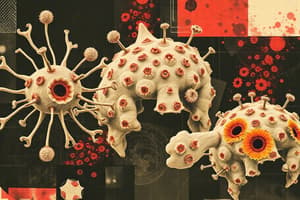Podcast
Questions and Answers
Explain the function of the complement system in immunity.
Explain the function of the complement system in immunity.
The complement system functions in both innate and adaptive immunity for defense against microbial pathogens. Complement proteins are present in inactive forms in the plasma, and many of them are activated to become proteolytic enzymes that degrade other complement proteins, thus forming an enzymatic cascade capable of tremendous amplification.
What are the three pathways for the cleavage of C3 in complement activation?
What are the three pathways for the cleavage of C3 in complement activation?
The three pathways for the cleavage of C3 in complement activation are the classical pathway, the alternative pathway, and the lectin pathway.
Describe the formation of the C3 convertase and its function.
Describe the formation of the C3 convertase and its function.
Complement activation leads to the formation of an enzyme called the C3 convertase, which splits C3 into two functionally distinct fragments, C3a and C3b. C3a is released, and C3b becomes covalently attached to the cell or molecule where the complement is being activated.
What is the ultimate result of complement activation and how does it occur?
What is the ultimate result of complement activation and how does it occur?
Inflammation is controlled by which regulatory proteins?
Inflammation is controlled by which regulatory proteins?
What are the key functions of C5a, C4a, and C3a in inflammation?
What are the key functions of C5a, C4a, and C3a in inflammation?
What is the role of C5a in inflammation?
What is the role of C5a in inflammation?
How do C3b and iC3b contribute to inflammation?
How do C3b and iC3b contribute to inflammation?
What is the function of the membrane attack complex (MAC) in inflammation?
What is the function of the membrane attack complex (MAC) in inflammation?
What are some other mediators of inflammation mentioned in the text?
What are some other mediators of inflammation mentioned in the text?
What characterizes acute inflammatory reactions?
What characterizes acute inflammatory reactions?
What is the defining feature of serous inflammation?
What is the defining feature of serous inflammation?
What is the main feature of fibrinous inflammation?
What is the main feature of fibrinous inflammation?
What does purulent (suppurative) inflammation lead to the production of?
What does purulent (suppurative) inflammation lead to the production of?
What are ulcers in the context of inflammation?
What are ulcers in the context of inflammation?
What are the outcomes of acute inflammation?
What are the outcomes of acute inflammation?
Flashcards
Complement System
Complement System
A group of proteins aiding in immune defense against pathogens.
C3 Cleavage Pathways
C3 Cleavage Pathways
The three pathways to activate C3: classical, alternative, and lectin.
C3 Convertase
C3 Convertase
An enzyme that splits C3 into C3a and C3b during activation.
C3a Function
C3a Function
Signup and view all the flashcards
C3b Function
C3b Function
Signup and view all the flashcards
Membrane Attack Complex (MAC)
Membrane Attack Complex (MAC)
Signup and view all the flashcards
C5a Role
C5a Role
Signup and view all the flashcards
Regulatory Proteins
Regulatory Proteins
Signup and view all the flashcards
Histamine Release
Histamine Release
Signup and view all the flashcards
Acute Inflammation Characteristics
Acute Inflammation Characteristics
Signup and view all the flashcards
Serous Inflammation
Serous Inflammation
Signup and view all the flashcards
Fibrinous Inflammation
Fibrinous Inflammation
Signup and view all the flashcards
Purulent Inflammation
Purulent Inflammation
Signup and view all the flashcards
Ulcers in Inflammation
Ulcers in Inflammation
Signup and view all the flashcards
Outcomes of Acute Inflammation
Outcomes of Acute Inflammation
Signup and view all the flashcards
Inflammatory Mediators
Inflammatory Mediators
Signup and view all the flashcards
Study Notes
Inflammation and its Mediators: Key Points
- C5a, C4a, and C3a are cleavage products of complement components that stimulate histamine release, increase vascular permeability, and cause vasodilation.
- C5a is a chemotactic agent for various types of white blood cells and activates the lipoxygenase pathway of arachidonic acid metabolism.
- C3b and iC3b act as opsonins and promote phagocytosis by neutrophils and macrophages.
- The deposition of the membrane attack complex (MAC) on cells results in their osmotic death (lysis), important for killing microbes.
- Complement activation is controlled by regulatory proteins such as C1 inhibitor, decay accelerating factor (DAF), CD59, and others.
- Other mediators of inflammation include Platelet-Activating Factor (PAF), Coagulation products, and Kinins.
- Acute inflammatory reactions are characterized by dilation of small blood vessels and accumulation of leukocytes and fluid in the extravascular tissue.
- Serous Inflammation involves exudation of cell-poor fluid into spaces created by injury, not infected by destructive organisms.
- Fibrinous Inflammation involves the formation and deposition of fibrin in the extracellular space, which may lead to scarring.
- Purulent (Suppurative) Inflammation leads to the production of pus, consisting of neutrophils, necrotic cell debris, and edema fluid.
- Ulcers are local defects or excavations of the surface of an organ or tissue, produced by the sloughing of inflamed necrotic tissue.
- Outcomes of acute inflammation include complete resolution, healing by connective tissue replacement (scarring), and progression to chronic inflammation when the acute response cannot be resolved.
Studying That Suits You
Use AI to generate personalized quizzes and flashcards to suit your learning preferences.




